Vírgenes y Santos
Santo Tomas. Sábado, jul. 3
Día de la Independencia. Domingo, jul. 4
San Benito. Domingo, jul. 11
Virgen del Carmen. Viernes, jul. 16
San Joaquín y Santa Ana. Lunes, jul. 26
Santa Marta. Jueves, jul. 29
Author Archives: Tereza Ma
Graduation 2021
Corpus Christi. La solemnidad del Cuerpo y la Sangre del Señor
Por Obispo Joseph R. Kopacz, D.D.
Profundamente arraigada en nuestra tradición de fe, en la fiesta de la Solemnidad del Cuerpo y la Sangre del Señor, nos reunimos alrededor del Altar del Sacrificio, como lo hicieron Moisés y los israelitas al pie del monte Sinaí, para renovar y celebrar nuestra Alianza, iniciada en el Bautismo, sellada con la sangre de la Cruz y confirmada en la Resurrección.
Los israelitas salieron de la esclavitud de Egipto a un lugar de libertad en el desierto, para reunirse como Pueblo de Dios. Nos estamos reuniendo de nuevo como el Cuerpo de Cristo, en mayor número después de un año de ser esparcidos, no por la opresión de un cruel Faraón, sino por una pandemia castigadora.
Mirando más atrás en nuestra tradición de fe, nos parecemos a Noé y su familia, incluidas todas las criaturas de Dios, que estaban confinadas en su hogar flotante, hasta el día en que pudieran poner un pie en la tierra y ofrecer sacrificios a Dios.
Así también, nosotros ponemos un pie en nuestras iglesias, de toda la diócesis, de una manera más ordinaria para ofrecer sacrificio al Dios y Padre de nuestro Señor Jesucristo.
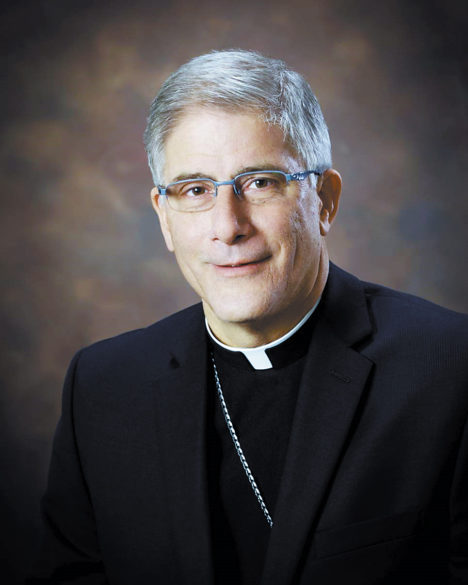
En la solemnidad más adecuada, aparte del Domingo de Resurrección, en la Solemnidad del Corpus Christi se levantó la dispensa de la obligación dominical, debidamente establecida durante más de un año, para que nuestros fieles católicos, el Cuerpo de Cristo, pudieran celebrar de nuevo el acto de culto sublime, la Santa Misa.
Me han inspirado, en este año pasado, todos los que se han reunido por hambre de la Palabra de Dios y del sacramento de la Eucaristía y todos los que han tenido un hambre profunda de estar físicamente presentes en la iglesia. Cada vez más, este anhelo se está cumpliendo a medida que la pandemia retrocede. Para aquellos que continúan separados debido a problemas de salud, espero que las circunstancias les permitan regresar a casa, más temprano que tarde.
En encuestas nacionales realizadas durante el año pasado, muchos expresaron que la pandemia, en medio del sufrimiento, la muerte y las privaciones, había fortalecido su fe en Dios y su vida espiritual. Los crisoles suelen hacer esto. Este crecimiento podría indicar una amplia gama de desarrollo personal, pero para nosotros como católicos, las señales externas de que nuestra fe en Jesucristo ha crecido son tangibles. Son el hambre de estar en comunión con él en el sacramento de su Cuerpo y Sangre, el hambre de ser parte viva del Cuerpo de Cristo, la comunidad reunida y el hambre y la sed que tenemos de justicia y reconciliación en nuestras relaciones, comenzando en casa y llegando a todos en nuestras vidas y en nuestro mundo.
El Papa Francisco continuamente aboga por un sentido más profundo de fraternidad en nuestro mundo que complemente la libertad y la igualdad. Su pasión por una mayor unidad y solidaridad entre los pueblos y las naciones surge de la fuente y cumbre de nuestra identidad católica, el santo sacrificio de la Misa.
El precioso cuerpo y la sangre del Señor es nuestro salvavidas en la fe. Cada día la Palabra de Dios resuena de acuerdo en toda la iglesia mundial, una luz en las tinieblas. El crucificado y resucitado es la luz del mundo, el pan de vida, el camino y la verdad. Su vida derramada por nosotros es alimento para el viaje y prenda de la vida eterna.
Qué precioso regalo y misterio celebramos en su amor eterno por nosotros. Cuán bendecidos somos cada vez que nos reunimos para la Eucaristía, profesando nuestra fe en que hacemos esto en memoria de Aquel que está con nosotros siempre hasta el fin de los tiempos y por toda la eternidad.
En el monte Tabor, la montaña de la Transfiguración, Pedro espetó, incrédulo de pura alegría: “Señor, ¡qué bien que estemos aquí!”. (Mateo 17: 4)
Estamos de acuerdo en que es bueno para nosotros estar de regreso en la iglesia, en nuestros lugares sagrados, donde podemos ver y celebrar la gloria de Dios que brilla en el rostro de Jesucristo, en la Solemnidad del Cuerpo y la Sangre del Señor, y durante todo el año. ¡Aleluya!
Youth
May crownings around the diocese
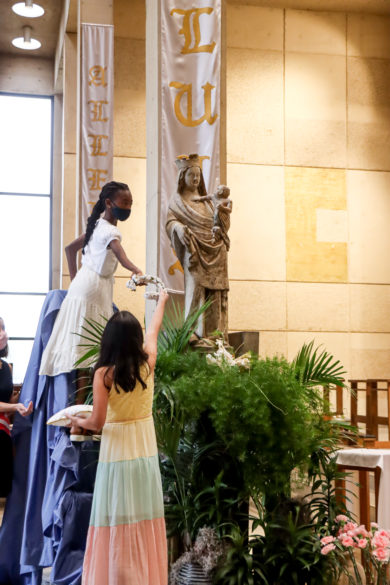
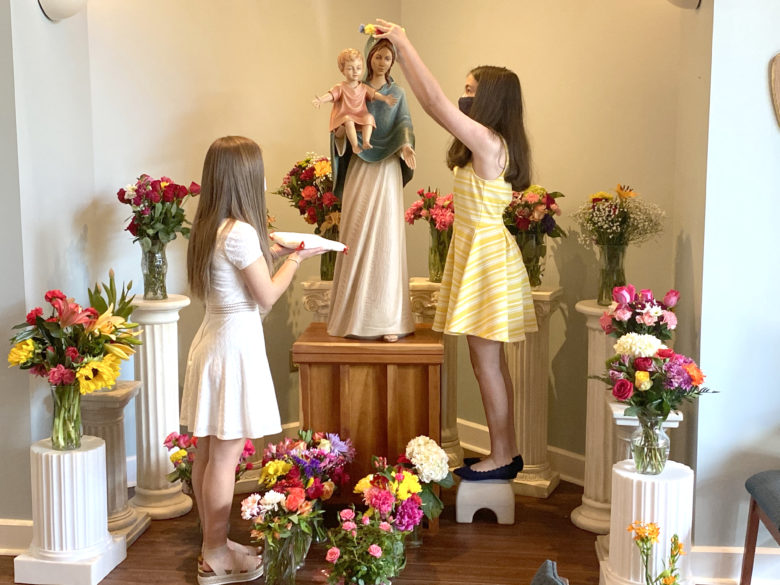
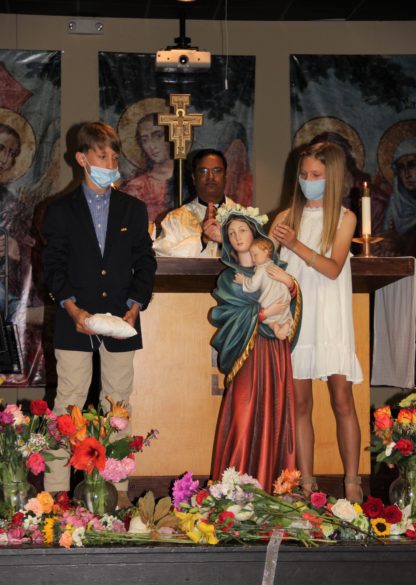
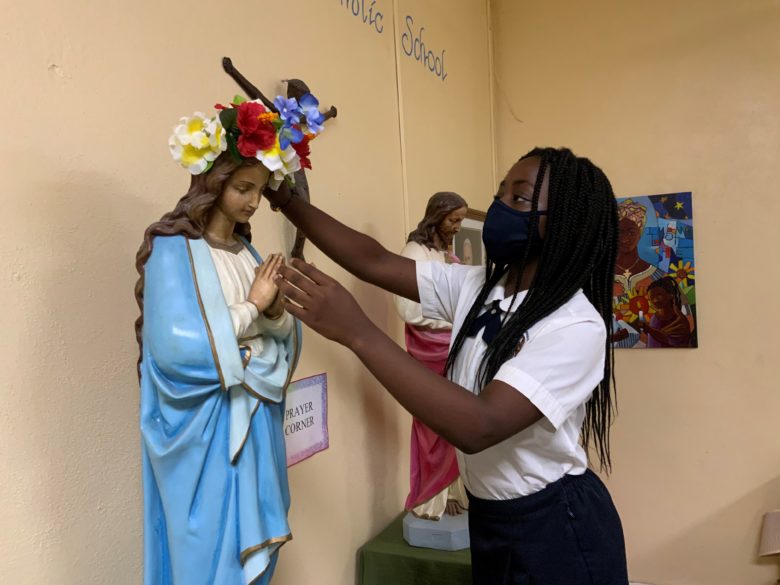
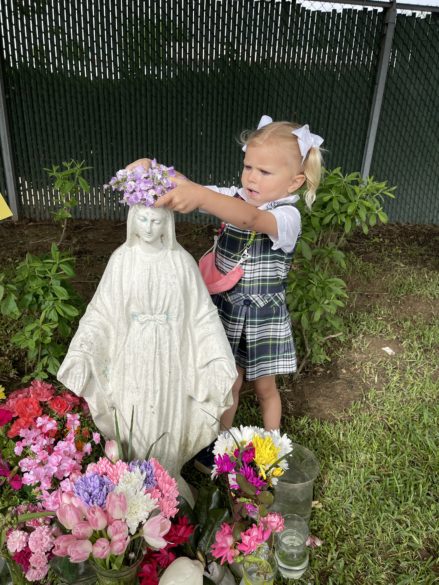
Crowning Mary Mass
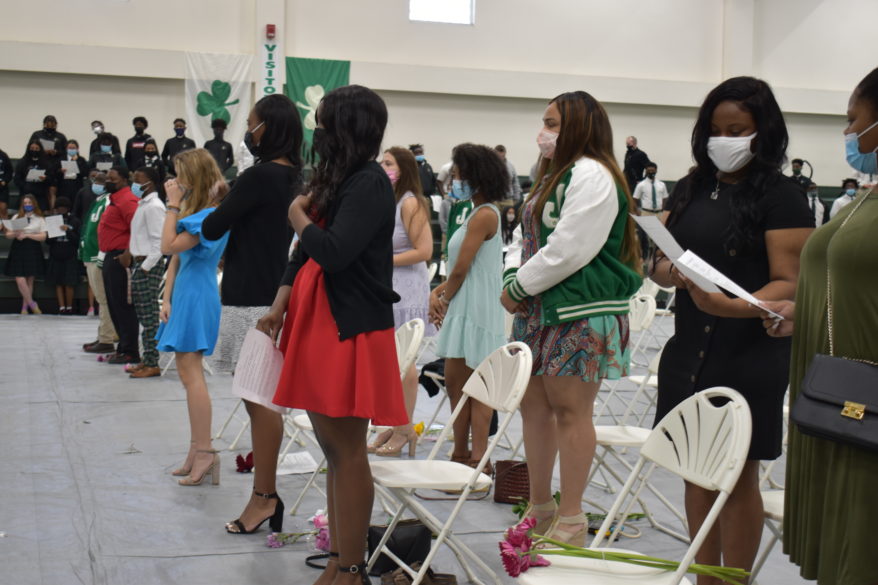
Field day fun

Running for education
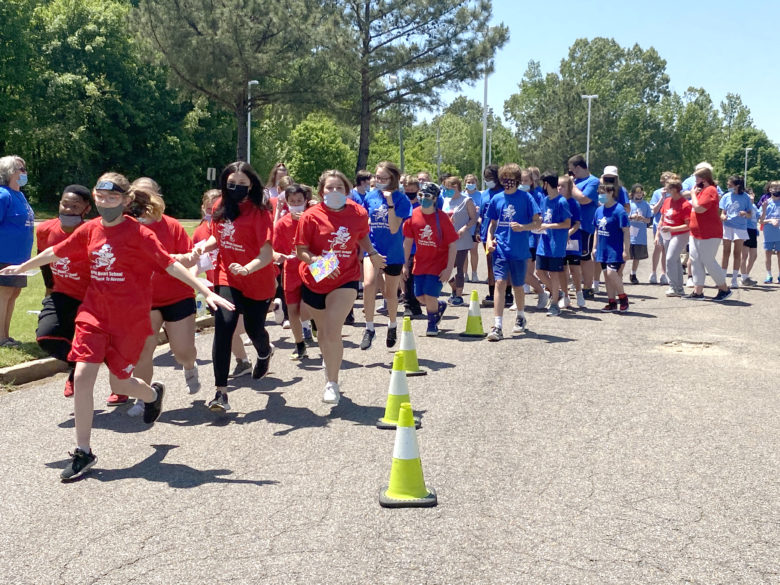
Bishop to lift dispensation from obligation to attend Mass, diocese issues modified directives
By Joanna Puddister King
JACKSON – After careful study and consultation with the clergy, Bishop Joseph Kopacz will lift the general dispensation from the Sunday obligation to attend Mass, effective on the Solemnity of the Feast of Corpus Christi beginning with the vigil Mass on Saturday, June 5, 2021.
In a letter released on May 20 by the diocese, Bishop Kopacz states, “The Sunday obligation will be restored on this great feast when we can satisfy our hunger for the Bread of Life, in Word and Sacrament with the reception of Holy Communion.”
Bishop Kopacz also reminds the faithful in his letter to keep in mind that the church always dispenses those confronting serious health concerns. “Therefore, someone can validly make the decision to attend Mass during the week, if able, and to participate in the Mass on the Lord’s Day through live streaming,”
In addition to lifting the general dispensation from the Sunday Mass obligation, the diocese modified their protocols during the pandemic. The directives, which represents a combination of previously released protocols, detail how parishes can move forward towards more normal operations, taking a gradual phased approach, with a watchful eye on the developments and guidance of the Centers for Disease Control (CDC) and the Mississippi State Department of Health.
For Masses, social distancing will be at 3 feet and parishes may use every pew, deciding how to stagger seating to maintain social distancing.
Also, masks are no longer required at Mass but encouraged for those who are not vaccinated and for children and youth under the age of 16. However, priests and eucharistic ministers are required to wear masks when distributing Holy Communion.
With the changes, some things remain the same. Holy Communion is still encouraged to be received in the hand and hand sanitizer should still be used by parishioners upon entrance to the church.
The updated protocols also include directives on meetings, gatherings, as well as youth activities and Vacation Bible School.
Pastors and their pastoral staff are responsible for the safe and prudent execution of the directives, recognizing that every parish has unique circumstances. The goal is to continue to provide a safe place for worship while maintaining a level of confidence for all the people of God.
On May 13, the CDC eased the mask-wearing guidance for fully vaccinated people allowing them to stop wearing masks outdoors in crowds and most indoor settings. The guidance still calls for wearing masks in crowded indoor settings like buses, planes, hospitals, prisons and homeless shelters.
Father Lincoln Dall, vicar general for the diocese, stated at the end of the directives, “We want to thank all of you for your efforts in keeping our parishioners safe during the pandemic. We acknowledge that all of us are very weary of dealing with the pandemic. … However, we acknowledge that this is still is not the time to let our guard down completely. We will continue to monitor the situation and will issue modified guidelines when the reality of the pandemic changes.”
To view the letter from Bishop Kopacz lifting the dispensation and a full list of updated protocols, visit https://jacksondiocese.org/public-health-concerns/.
Obispo, en directivas modificadas, levantará dispensa de obligación de asistir a Misa
Por Joanna Puddister King
JACKSON – Después de un estudio cuidadoso y una consulta con el clero, el obispo Joseph Kopacz levantará la dispensa general de la obligación dominical de asistir a la misa, a partir de la fiesta de Corpus Christi, de la Misa de vigilia el sábado 5 de junio de 2021.
En una carta publicada por la diócesis, el 20 de mayo, el obispo Kopacz declara: “La obligación dominical será restaurada en esta gran fiesta cuando podamos satisfacer nuestra hambre por el Pan de Vida, en la Palabra y Sacramento con la recepción de la Sagrada Comunión.”
El obispo Kopacz recuerda a los fieles en su carta que tengan también en cuenta que la iglesia siempre dispensa a aquellos que enfrentan problemas de salud graves. “Por lo tanto, alguien puede tomar válidamente la decisión de asistir a Misa, si puede, durante la semana y participar en la Misa el día del Señor a través de la transmisión en vivo.”
Además de levantar la dispensa general de la obligación de la Misa dominical, la diócesis modificó sus protocolos durante la pandemia. Las directivas, que representan una combinación de protocolos publicados anteriormente, detallan cómo las parroquias pueden avanzar hacia operaciones más normales, adoptando un enfoque gradual, con una mirada atenta a los desarrollos y la orientación del Centro para el Control de Enfermedades (CDC) y el Departamento de Salud del Estado de Mississippi.
El distanciamiento social será de 3 pies para las Misas y las parroquias pueden usar cada banco para decidir cómo escalonar los asientos para mantener el distanciamiento social.
Además, las máscaras ya no se requieren en la Misa, pero se recomiendan para aquellos que no están vacunados y para niños y jóvenes menores de 16 años. Sin embargo, los sacerdotes y ministros eucarísticos deben usar máscaras al distribuir la Sagrada Comunión.
Con los cambios, algunas cosas seguirán igual. Todavía se anima a recibir la Sagrada Comunión en la mano y los feligreses deben usar desinfectante de manos al entrar a la iglesia.
Los protocolos actualizados también incluyen directivas sobre reuniones, encuentros, así como actividades para jóvenes y la Escuela Bíblica de Vacaciones.
Los párrocos y su personal pastoral son responsables de la ejecución segura y prudente de las directivas, reconociendo que cada parroquia tiene circunstancias únicas. El objetivo es continuar proporcionando un lugar seguro, para la adoración mientras se mantiene un nivel de confianza en todo el pueblo de Dios.
El 13 de mayo, el CDC modificó la guía para el uso de máscaras para las personas completamente vacunadas, lo que les permitió dejar de usar máscaras al aire libre en multitudes y en la mayoría de los entornos interiores. La guía todavía exige el uso de máscaras en entornos interiores abarrotados como autobuses, aviones, hospitales, prisiones y refugios para personas sin hogar.
El padre Lincoln Dall, vicario general de la diócesis, declaró al final de las directrices: “Queremos agradecerles a todos por sus esfuerzos para mantener seguros a nuestros feligreses durante la pandemia. Reconocemos que todos estamos muy cansados de lidiar con la pandemia. … Sin embargo, reconocemos que todavía no es el momento de bajar la guardia por completo. Continuaremos monitoreando la situación y emitiremos lineamientos modificados cuando la realidad de la pandemia cambie.”
Para ver la carta del obispo Kopacz levantando la dispensa y para una lista completa de los protocolos actualizados, visite https://jacksondiocese.org/public-health-concerns/
Leguaje del amor
“ Tener amor es saber soportar;
es ser bondadoso;
es no tener envidia, ni ser presumido,
ni orgulloso, ni grosero, ni egoísta;
es no enojarse ni guardar rencor;
es no alegrarse de las injusticias,
sino de la verdad.
Tener amor es sufrirlo todo, creerlo todo, esperarlo todo, soportarlo todo.” Co 13: 4-7.
Por Obispo Joseph R. Kopacz, D.D.
Mientras las naciones se encolerizan, la iglesia proclama elocuentemente en la fe del Pentecostés: Señor Jesús tu vienes a reunir a las naciones en la paz del Reino de Dios. Tu vendrás en palabra y sacramento para fortalecernos en santidad. Vendrás en gloria con salvación para tu pueblo. Mientras nos esforzamos fielmente por cumplir la Gran Comisión del Señor de hacer discípulos en todas las naciones, también aceptamos la enorme tarea de construir el Reino de los Cielos en la tierra dondequiera que se proclame el Evangelio, Romanos 14:17, cuyos signos son la justicia, la paz y el gozo en el Espíritu Santo.

La Tierra Santa en la que Jesús y sus primeros discípulos se cruzaron para anunciar el Reino de Dios, sigue trágicamente atormentada sin tregua por el odio, la violencia y el conflicto guerrerista. La tregua, que puso fin a la última ronda de malicia, es tan frágil como un nido de pájaros en medio de depredadores hambrientos. Sin embargo, como discípulos del Señor en una iglesia universal, el Espíritu Santo nos impulsa a superar la complacencia y la indiferencia, el cinismo y la desesperación por el beneficio común y la salvación de todos.
El sueño de Dios para nuestro mundo, a través del derramamiento del Espíritu Santo, es profundamente personal e inexorablemente universal. En nuestra condición de seres únicos, el Señor llama a cada uno de nosotros a arrepentirnos y reconciliarnos con Dios por nuestra propia salvación y por el bien de todos. Esta es una vida en comunidades de fe, de una iglesia mundial, donde la singularidad y la diversidad están destinadas a crear lazos de unidad. Cuando vemos la división en nuestra iglesia, nación y mundo nos preguntamos si la unidad y la diversidad estarán siempre fuera de nuestro alcance.
Cuando estamos atrapados por este caos, el Espíritu Santo siempre nos redirige de regreso a Jesús, derramamiento máximo divino, por el poder de la crucifixión, resur-
rección y ascensión. En la lectura de la carta de Pablo en Gálatas 5:19ss en el domingo de Pentecostés, después de reconocer la oscuridad que habita dentro de cada uno de nosotros, se ilustran los frutos del Espíritu Santo y la fuente de la que brotan.
“Y los que son de Cristo Jesús, ya han crucificado la naturaleza del hombre pecador junto con sus pasiones y malos deseos. Si ahora vivimos por el Espíritu, dejemos también que el Espíritu nos guíe.“ Ga 5: 24-25 Es muy importante si vivimos por el Espíritu, pues eso determina cómo caminamos; determinará si podemos crear unidad mientras apreciamos la diversidad, o si nos revolcaremos en la división o, peor aún, en la violencia, el terror y la guerra entre las naciones.
En medio de enormes divisiones entre la comunidad cristiana primitiva en Corinto, empañada por juicios, inmoralidad sexual, desprecio por los pobres, abusos en la Cena del Señor, facciones y negación de la resurrección por nombrar algunos, San Pablo se mantuvo firme en su creencia de que el Espíritu Santo podía sacar el orden divino del caos. “Hay en la iglesia diferentes dones, pero el que los concede es un mismo Espíritu. Hay diferentes maneras de servir, pero todas por encargo de un mismo Señor. Y hay diferentes manifestaciones de poder, pero es un mismo Dios, que, con su poder, lo hace todo en todos. Dios da a cada uno alguna prueba de la presencia del Espíritu, para provecho de todos.” 1Co12: 4-7
Lo que sigue es una parte del testimonio más anunciado compuesto sobre el amor y que San Pablo escribió de “la manera más excelente.”
“Tener amor es saber soportar; es ser bondadoso; es no tener envidia, ni ser presumido, ni orgulloso, ni grosero, ni egoísta; es no enojarse ni guardar rencor; es no alegrarse de las injusticias, sino de la verdad. Tener amor es sufrirlo todo, creerlo todo, esperarlo todo, soportarlo todo.” Co 13: 4-7 El Espíritu Santo les dio a los corintios una salida de su caos y un camino a seguir para cada comunidad cristiana de todos los tiempos, de una generación a la siguiente.
Los historiadores y los eruditos bíblicos pueden desconcertar la venida del Espíritu Santo y su significado hace 2000 años. Pero para aquellos de nosotros que estamos comprometidos con el ministerio cristiano y la divulgación, no puede haber duda de que el idioma que se hablaba entonces y ahora, es el que cualquier persona puede entender. Es el lenguaje del Evangelio, la Buena Nueva. Es el lenguaje del amor. Sí, es por eso por lo que Pentecostés sigue vivo.
Ven Espíritu Santo, llena los corazones de tus fieles y enciende en ellos el fuego de tu amor.
Pope appeals for peace in Holy Land, says death of children ‘unacceptable’
By Cindy Wooden
VATICAN CITY (CNS) – The injury and death of so many innocent people, especially children, caused by escalating violence between Israel and the Gaza Strip is “terrible and unacceptable,” putting the area at risk of sinking into “a spiral of death and destruction,” Pope Francis said.
The pope launched an appeal for calm and asked leaders of both sides “to put a stop to the roar of weapons and to follow the paths of peace, even with the help of the international community,” he said May 16 after reciting the “Regina Coeli” prayer with hundreds of people in St. Peter’s Square.
“Many people have been injured and many innocent people have died. Among them are even children, and this is terrible and unacceptable. Their death is a sign that one does not want to build the future, but wants to destroy it,” he said.
The growing hatred and violence in different cities in Israel “is a serious wound to fraternity and to peaceful coexistence among citizens, which will be difficult to heal if we do not open immediately to dialogue,” the pope said, asking, “Where will hatred and vengeance lead? Do we really think we can build peace by destroying the other?”
The pope appealed for calm, a cease-fire and constant prayers so that “Israelis and Palestinians may find the path of dialogue and forgiveness, to be patient builders of peace and justice, opening up, step by step, to a common hope, to a coexistence among brothers and sisters.”

He then led those gathered in the square in praying the Hail Mary for the victims, the children and for peace.
Meanwhile, the head of the Vatican’s press office, Matteo Bruni, confirmed that Pope Francis spoke over the telephone May 17 with Turkey’s President Recep Tayyip Erdogan.
While the Vatican did not comment on the content of the conversation, the Turkish communications department said the two leaders discussed the ongoing attacks.
According to a written statement reported by Andalou Agency, Erdogan said Israel’s attacks were an atrocity and that the latest violations were putting regional security in danger.
Pope Francis’ appeal May 16 came as Israel escalated its assault on Gaza and it also faced growing civil unrest in its mixed Jewish-Arab cities.
Jewish mobs had destroyed Arab property, and Arab mobs attacked Jewish businesses and burned synagogues, with attempted lynchings on both sides over the past week.
The violence between Israel and Hamas was at its worst since the 2014 Gaza War with Israeli airstrikes and hundreds of rockets launched from the Gaza Strip killing at least 145 Palestinians and 10 Israelis, according to Reuters May 16. Efforts by the international community were underway to broker a cease-fire.
Pneuma: can you hear me now?
From the hermitage
By sister alies therese
The ‘season of the Spirit’ is upon us and have we used the many opportunities to explore the ‘beauty?’ As we ‘turn green’ from the glory of Easter/Pentecost’s golds and reds we are called to practically live out what has been given. We discover in the Scriptures and from contemporary writers, the various ways this Pneuma has been heard and experienced. What sort of life might we live having received such ourselves? How do we set ourselves up to receive? How do we respond to the generosity and kindness of God?
Carlo Carretto, (Selected Writings, 1994, Ellsberg, Ed. page 83) … points us to our reality:
“And then, what do rocks matter? What matters is Christ’s promise, what matters is the cement that binds the rocks into one: the Holy Spirit. The Holy Spirit alone can build the Church with stones as ill-hewn as we.”
To admit I am ill-hewn is always an ‘ouch’ as I’m pretty sure God meant better for us! But the Spirit shows me a different picture and promises to transform. Pope Francis in the Joy of the Gospel (2013) speaks of:
“Spirit-filled evangelizers, fearlessly open to the working of the Holy Spirit … Jesus wants evangelizers who proclaim the good news not only with words but above all a life transfigured by God’s presence…”
And then the Scriptures showed us:
“A strong heavy wind was rending the mountains and crushing the rocks before the Lord — but the Lord was not in the wind … and after the fire there was a whispering sound. When he heard this Elijah hid his face in his cloak.” (1Kings 9)
“The tiny whisper is imperceptible and tells of the spirituality of God. It was fitting Elijah, whose mission it was to re-establish the covenant and restore the pure faith, would have returned to Horeb where the covenant was revealed to Moses and through him to Israel’s people.” (NAB, notes, page 336)
Have we heard the driving wind or the small voice? God is generous, clearly a hope in us that we don’t miss our call, indeed, that we get the memo!
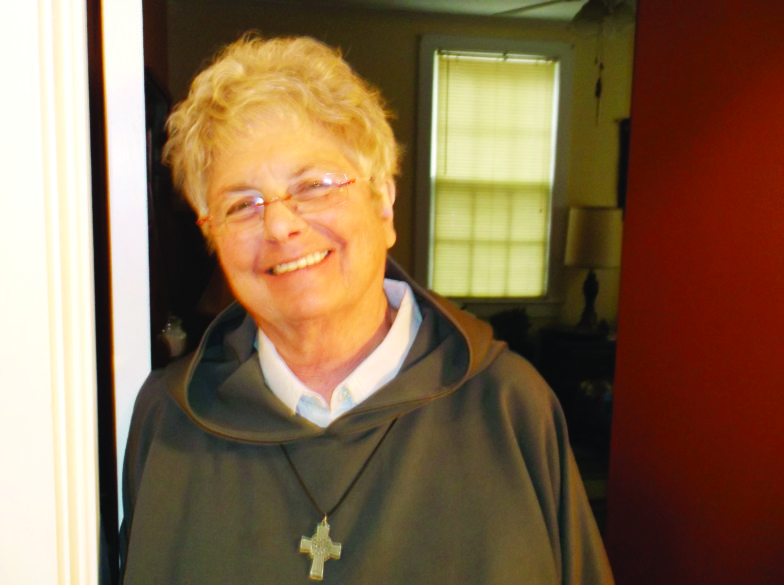
“From up in the sky there came a noise like a strong, driving wind: the wind and the Holy Spirit are associated in John 3:8: ‘the wind blows where it will. You hear the sound it makes but you do not know where it comes from nor where it goes. So it is with everyone begotten of the Spirit.’” (NAB, notes, page 1172)
I don’t know where I’m going half the time (perhaps not in an ‘ultimate sense’). Is this a blessing of aging? Anyway, this Spirit does not just call on us once … or even twice. Frequently we can hear that whisper, or large boom, when we are at prayer, or trying to pray. Note:
CCC 2623: On the day of Pentecost, the Spirit of the Promise was poured out on the disciples, gathered ‘together in one place. While awaiting the Spirit, ‘all these with one accord devoted themselves to prayer.’ The Spirit who teaches the church and recalls for her everything Jesus said was also to form her in a life of prayer.”
CCC 2655: …Prayer internalizes and assimilates the liturgy during and after celebration. Even when it is lived out ‘in secret’, prayer is always the prayer of the church; it is a communion with the Holy Trinity.’
So, the coming of God’s Spirit is really to form us ill-hewn ones for prayer, for that marvelous encounter with Jesus. If God, as Spirit, has gotten our attention, what next? W. H. Auden in Prayer, the Nature of in a Certain World, 1970, writes:
“To pray is to pay attention to something or someone other than oneself. Whenever one so concentrates attention…that one completely forgets the ego and desires, one is praying.
To forget my ego … ah, that is where I am indeed ill-hewn! You?
In Praying With Icons, Jim Forest, 1997, points out:
“When the Most High came down and confused the tongues, God divided the nations. But when God distributed tongues of fire, God called everyone to unity. Therefore with one accord we glorify the all-Holy Spirit.” — Kontakion for Pentecost
How is this Spirit wending her way through our pandemic ridden world? Are we not, indeed a people in darkness awaiting illumination? Are we not a people called to unity, burned together by this fire? This unity comes in prayer and action, and trust in an unseen God.
Finally, in The Word in the Desert, Douglas Burton-Christie 1993, mentions Abba Cronius, who reminds the brothers/sisters that “vigilance, singlemindedness, and abandonment to God’s will gives birth to the Holy Spirit in one’s soul.” (page 207)
We pray the Spirit will give us just these graces for that birth that we might together glorify God, ill-hewn as we are.
Blessings.
(Sister alies therese is a canonically vowed hermit with days formed around prayer and writing.)
High court to hear major abortion case from Mississippi in its next term
WASHINGTON (CNS) – The U.S. Supreme Court said in a May 17 order that it will hear oral arguments during its next term on a 2018 Mississippi abortion law banning most abortions after 15 weeks of pregnancy.
The case is Dobbs v. Jackson Women’s Health Organization. The court’s term opens in October and a decision is expected by June 2022.
Just after then-Mississippi Gov. Phil Bryant signed the law March 19, 2018, a federal judge blocked it temporarily from taking effect after the state’s only abortion clinic filed suit, saying it is unconstitutional. The U.S. Court of Appeals for the Fifth Circuit upheld the block on the law.
In commending Bryant for his signature, the state’s Catholic bishops, Bishop Joseph R. Kopacz of Jackson and Bishop Louis F. Kihneman III of Biloxi, said: “(We) wish to reaffirm the sacredness of human life from conception until natural death. With Pope St. John Paul II, we recognize abortion as ‘a most serious wound inflicted on society and its culture by the very people who ought to be society’s promoters and defenders.’”
In 2020, the Jackson and Biloxi dioceses filed a friend-of-the-court brief in support of Mississippi Attorney General Lynn Fitch’s petition to the Supreme Court asking it to review the 5th Circuit’s ruling prohibiting the state from enforcing the law.
The high court should clarify current law on abortion “in light of a state’s interests in protecting the sanctity of life,” the dioceses’ brief said.
A number of states have passed laws restricting abortion that have been challenged in court by supporters of legal abortion. Pro-life advocates have been hoping one or more of those laws would be taken up by the Supreme Court as a way to challenge 1973’s Roe v. Wade decision legalizing abortion.
The Mississippi case will be the first abortion case the court will consider since the Oct. 26, 2020, confirmation of now-Justice Amy Coney Barrett, President Donald Trump’s third pick for the court. His first two picks, Justices Brett Kavanaugh and Neil Gorsuch, were on the court when it took up its first major abortion decision since they were confirmed.
The case was a Louisiana law requiring abortion providers to have admitting privileges at local hospitals.
The court struck it down as unconstitutional in a 5-4 ruling. Chief Justice John Roberts joined Justices Stephen Breyer, Sonia Sotomayor, Elena Kagan and Ruth Bader Ginsburg in knocking down the law. Kavanaugh and Gorsuch joined Justices Samuel Alito and Clarence Thomas in upholding the law.

The upcoming Mississippi case – it has been on the Supreme Court’s docket as a potential case since last fall – will examine the question of viability, specifically if a fetus can survive on its own at 15 weeks.
Pro-life advocates were pleased with the court’s decision to take this case.
“We applaud the U.S. Supreme Court for examining the Mississippi law,” said Carol Tobias, president of National Right to Life, who stressed that so much more is known now about viability with advanced technology.
Eric Scheidler, executive director of the Pro-Life Action League based in Chicago, said many activists see this as “an opportunity for the high court to overturn Roe v. Wade” or at the very least to “bring abortion policy in the United States in line with rest of the world, where abortion is strictly limited after 12-15 weeks.”
Similarly, Jeanne Mancini, president of March for Life, said the United States “is one of only seven countries – including China and North Korea – that allows abortions through all nine months of pregnancy.”
“An overwhelming majority of Americans agree that this goes way too far,” she said. “In fact 70% think abortion should be limited to – at most – the first three months of pregnancy.”
In a May 17 statement she added: “States should be allowed to craft laws that are in line with both public opinion on this issue as well as basic human compassion, instead of the extreme policy that Roe imposed.”
Thomas Olp, vice president and senior counsel for the Thomas More Society, a nonprofit national public interest law firm, said his firm, on behalf of Illinois Right to Life, has “argued against the now long-outdated science behind Roe v. Wade and urged the court to uphold the subsequent 14th Amendment rights due the preborn.”
Activists were not the only ones to respond in favor of the court taking the case.
Sen. Steve Daines, R-Mont., chair of the new Senate pro-life caucus, tweeted May 17 that he was encouraged the court decided to hear it.
“There is no constitutional right to abortion, yet for nearly 50 years since Roe v. Wade was wrongly decided, more than 62 million children have been the tragic victims of abortion. It is long past time for the Supreme Court to right this wrong,” he said.
O. Carter Snead, law school professor at the University of Notre Dame, said the court agreeing to take this case “signals the possibility that it may finally end its failed and constitutionally unjustified experiment as the nation’s ad hoc abortion regulatory body of last resort.”
He said the court’s “tortured reading of the Constitution has undermined the rule of law, broken our electoral politics and resulted in a staggering number of lives lost. It is time once and for all for the Supreme Court to return to its role as faithful interpreter of the Constitution and to repair the damage it caused years ago.”
